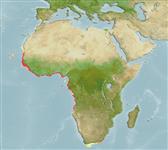Environment: milieu / climate zone / depth range / distribution range
Ökologie
seewasser; brackwasser demersal. Tropical
Eastern Atlantic: Senegal to Angola (Ref. 57400). Also reported from Mauritania (Ref. 55783).
Length at first maturity / Size / Gewicht / Alter
Maturity: Lm 20.5 range ? - ? cm
Max length : 40.0 cm TL Männchen/unbestimmt; (Ref. 2683); common length : 30.0 cm TL Männchen/unbestimmt; (Ref. 2683)
Afterflossenstacheln 3; Afterflossenweichstrahlen: 8 - 9. Diagnosis: body moderately stout, rounded in cross-section; head large, interorbital space almost flat; adipose eyelid well developed, extending unto pupil; upper lip thin, not ornamented (Ref. 57400). Upper lip with single comb-like series of setiform/cilliform, recurved (Ref. 57400, 81659), longish (Ref. 57400) unicuspid teeth, just visible to the naked eye as a fine fringe, and no inner rows (Ref. 81659). Lower lip without teeth, or with a single comb-like series of minute ciliiform teeth (not visible to naked eye) (Ref. 81659). 2nd row at base of lower lip in small fish (Ref. 57400). Hind end of upper jaw reaching a vertical line from posterior nostril; maxillary pad not visible below corner of mouth when closed; origin of first dorsal fin nearer to snout tip than to caudal-fin base; pectoral axillary process well developed (31.5-33% of pectoral-fin length)(Ref. 57400). 11-12 scale rows between origins of 1st dorsal and pelvic fins; anterior parts and bases of second dorsal and anal fins (sparsely) scaled; pelvic fins, anal and lower caudal fin lobe greyish to more or less whitish (never yellowish) (Ref. 57400, 81659).
Inhabits coastal waters (Ref. 2683, 7399, 57400), estuaries (Ref. 2683, 7399, 81659), inshore marine waters and lagoons (Ref. 81659). Also in high salinity waters (up to 73‰)(Ref. 57400). Feeds on phytoplankton and detritus (Ref. 28587). Oviparous, eggs are pelagic and non-adhesive (Ref. 205). Maximum FL reporded 260mm (Ref. 57400), maximum SL 260 mm, common length 200 mm SL (Ref. 81659).
Life cycle and mating behavior
Geschlechtsreife | Fortpflanzung | Ablaichen | Eier | Fecundity | Larven
Thomson, J.M., 1986. Mugilidae. p. 344-349. In J. Daget, J.-P. Gosse and D.F.E. Thys van den Audenaerde (eds.) Check-list of the freshwater fishes of Africa (CLOFFA). ISNB, Brussels, MRAC; Tervuren; and ORSTOM, Paris. Vol. 2. (Ref. 3573)
IUCN Rote Liste Status (Ref. 130435)
Bedrohung für Menschen
Harmless
Nutzung durch Menschen
Fischereien: kommerziell
Mehr Information
ReferenzenAquakulturAquakultur ProfilZuchtlinienGenetikElectrophoresesVererbbarkeitKrankheitenVerarbeitungNutrientsMass conversion
PartnerBilderStamps, Coins Misc.LauteCiguateraGeschwindigkeitSchwimmstilKiemenoberflächeOtolithsGehirngrößeSehfähigkeit
Tools
Zusatzinformationen
Download XML
Internet Quellen
Estimates based on models
Preferred temperature (Ref.
123201): 23.4 - 27.9, mean 26.5 °C (based on 64 cells).
Phylogenetic diversity index (Ref.
82804): PD
50 = 0.5000 [Uniqueness, from 0.5 = low to 2.0 = high].
Bayesian length-weight: a=0.01202 (0.00742 - 0.01949), b=2.98 (2.85 - 3.11), in cm total length, based on LWR estimates for this species & Genus-body shape (Ref.
93245).
Trophic level (Ref.
69278): 2.8 ±0.32 se; based on food items.
Generation time: 3.4 ( na - na) years. Estimated as median ln(3)/K based on 2
growth studies.
Widerstandsfähigkeit (Ref.
120179): hoch, Verdopplung der Population dauert weniger als 15 Monate. (Preliminary K or Fecundity.).
Fishing Vulnerability (Ref.
59153): Low vulnerability (22 of 100).
Nutrients (Ref.
124155): Calcium = 405 [157, 1,261] mg/100g; Iron = 3.22 [0.59, 16.23] mg/100g; Protein = 19.4 [17.8, 20.9] %; Omega3 = 0.391 [0.171, 0.931] g/100g; Selenium = 129 [42, 423] μg/100g; VitaminA = 11.2 [3.4, 34.9] μg/100g; Zinc = 2.67 [1.26, 6.32] mg/100g (wet weight);
